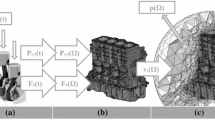Abstract
In this paper, a coupled modeling method considering cylinder liner vibration and coolant cavitation is proposed. The difference in coolant cavitation caused by combustion pressure variations is investigated. Based on a piston–cylinder liner transient dynamics model, the dynamic response of the liner under the piston slap is simulated and verified by bench test. Subsequently, the simulated vibrations are input into the flow field in the form of a dynamic mesh, and the pressure fluctuation and cavitation of the two diesel engines are investigated. The main causes of cavitation in the cylinder liner of high combustion pressure diesel engine are analyzed by combining experiments and numerical simulations. The results show that the main cause of cavitation is intensified vibration of the cylinder liner because of increased combustion pressure. The cavitation distribution in the axial direction is related to the modal properties of the cylinder liner.























Similar content being viewed by others
References
G. Li, F. Gu, T. Wang et al., Investigation into the vibrational responses of cylinder liners in an IC engine fueled with biodiesel. Appl. Sci. 7(7), 717 (2017)
Y. Xu, L. Yao, B. Zhang et al., Cavitation erosion and wear behavior of a boron cast iron cylinder liner under bio-fuel conditions. RSC Adv. 6(83), 79968–79970 (2016)
S. Hattori, T. Hirose, K. Sugiyama, Prediction method for cavitation erosion based on measurement of bubble collapse impact loads. Wear. 269(7–8), 507–514 (2010)
J. Chen, R.B. Randall, B. Peeters, Advanced diagnostic system for piston slap faults in IC engines, based on the non-stationary characteristics of the vibration signals. Mech. Syst. Signal Process. 75, 434–454 (2016)
C.T. Kwok, H.C. Man, F.T. Cheng et al., Developments in laser-based surface engineering processes: with particular reference to protection against cavitation erosion. Surf. Coat. Technol. 291, 189–204 (2016)
M. Abreu, J. Sundberg, J. Elfsberg et al., Morphology and mechanisms of cavitation damage on lamellar gray iron surfaces. Wear. 456, 203324 (2020)
X. Wang, K. Ohta, Study on piston slap induced liner cavitation. J. Vib. Acoust. 137(5), 051010 (2015)
S. Fontanesi, M. Giacopini, Multiphase CFD–CHT optimization of the cooling jacket and FEM analysis of the engine head of a V6 diesel engine. Appl. Therm. Eng. 52(2), 293–303 (2013)
T. Yonezawa, H. Kanda et al., Study of cavitation erosion on cylinder liner and cylinder block. J. Mar. Eng. Soc. Japan. 19, 384–390 (1984)
T. Yonezawa, A study on cavitation of cylinder liner and cylinder block. J. Mar. Eng. Soc. Japan. 20, 258–264 (1985)
T. Yonezawa, J. Senda, M. Saito et al., Behavior of bubbles in a cavitation field. Trans. Japan Soc. Mech. Eng. 35, 1894–1900 (1987)
B. Steck, G. Sommerfeld, V. Schneider, Cavitation on Wet cylinder liners of heavy-duty diesel engines. SAE Technical Paper (2006).
B. Steck, Avoiding cavitation on wet cylinder liners of heavy-duty diesel engines by parameter changes. SAE Technical Paper (2008).
L.I. Pogodaev, D.V. Tret’Yakov, A.G. Valishin et al., Simulation of durability of cylinder liners of an internal combustion engine under vibration cavitation. J. Mach. Manuf. Reliab. 37(2), 143–151 (2008)
D. **a, H. Zhang, 3D numerical simulation of the cavitation characteristics of cooling-water flow of cylinder liners for diesel engines. Adv. Sci. Lett. 4(6–7), 2132–2136 (2011)
H.Q. Dong, H.H. Feng, B. Dong et al., Dynamic modeling and cavitation tendency analysis of cylinder liner considering the effects of moving loads. Trans. CSISE. 31(5), 467–472 (2013)
X. Peiyou, G. Dao**g, H. Guannan et al., Influence of piston pin hole offset on cavity erosion of diesel engine cylinder liner. Eng. Fail. Anal. 103, 217–225 (2019)
S. Fontanesi, M. Giacopini, G. Cicalese et al., Numerical investigation of the cavitation damage in the wet cylinder liner of a high-performance motorbike engine. Eng. Fail. Anal. 44, 408–423 (2014)
K. Ohta, X. Wang, A. Saeki, Piston slap induced pressure fluctuation in the water coolant passage of an internal combustion engine. J. Sound Vib. 363, 329–344 (2016)
A. Deku, P. Nyanor, Harmonic analysis of cavitation in engine cooling fluid due to piston-cylinder assembly forces. Procedia Manuf. 7, 316–326 (2017)
A. Farshidianfar, M.H. Farshidianfar, M.J. Crocker et al., Vibration analysis of long cylindrical shells using acoustical excitation. J. Sound Vib. 330(14), 3381–3399 (2011)
Z. Geng, J. Chen, Investigation into piston-slap-induced vibration for engine condition simulation and monitoring. J. Sound Vib. 282(3–5), 735–751 (2005)
F.R. Menter, M. Kuntz, R. Langtry, Ten years of industrial experience with the SST turbulence model. Turbul. Heat Mass Transf. 4(1), 625–632 (2003)
A.K. Singhal, M.M. Athavale, H. Li et al., Mathematical basis and validation of the full cavitation model. J. Fluids Eng. 124(3), 617–624 (2002)
Author information
Authors and Affiliations
Corresponding author
Additional information
Publisher's Note
Springer Nature remains neutral with regard to jurisdictional claims in published maps and institutional affiliations.
Rights and permissions
Springer Nature or its licensor (e.g. a society or other partner) holds exclusive rights to this article under a publishing agreement with the author(s) or other rightsholder(s); author self-archiving of the accepted manuscript version of this article is solely governed by the terms of such publishing agreement and applicable law.
About this article
Cite this article
Liu, P., Tan, R., Li, L. et al. Cavitation Failure Analysis of Cylinder Liner in Diesel Engines Caused by Increased Combustion Pressure. J Fail. Anal. and Preven. 24, 625–638 (2024). https://doi.org/10.1007/s11668-023-01851-0
Received:
Accepted:
Published:
Issue Date:
DOI: https://doi.org/10.1007/s11668-023-01851-0




